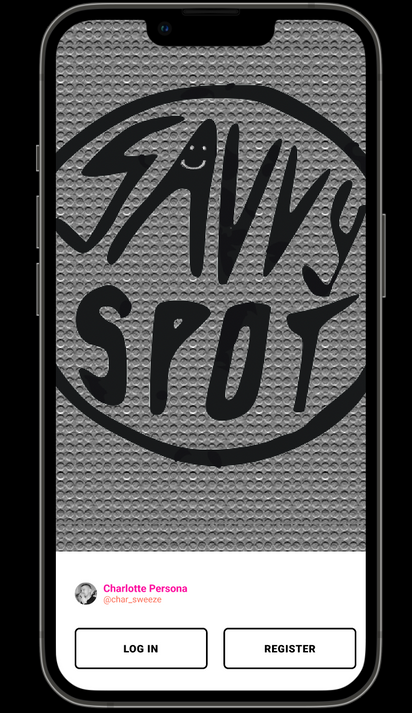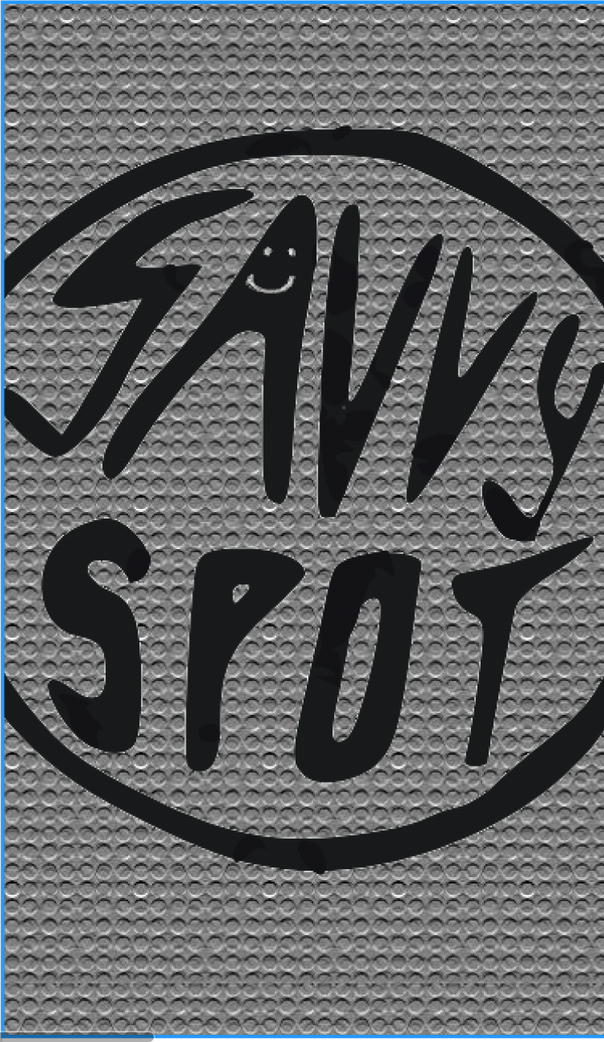
Savvy
spot
GLIS 627: User centerEd design
design profolio
By Group 5: Brynna Childs, Leyi Luo, Hana Gill, Banafsheh Mohajeri, Saiyan Islam
Problem statement
Due to external concerns (re: Coronavirus), the Greater Montreal ring of local food establishments faces several challenges, such as diminished customer support, forced closures and/or restructuring.
Consequently, it has become increasingly difficult for new businesses to find ways to promote themselves and compete with already established businesses and chains. Online dining applications heavily emphasize rating/review features (e.g. the 1-5 star scale), which are not optimized for small or new businesses; one or a few low ratings can be especially detrimental. Many individuals greatly value the opinions of their own personal network (e.g. friends/family) with food establishment recommendations; however, many dining apps do not have or are geared towards a more personal social networking where people are able to interact with individuals they know.
Is it possible to intersect the gap between the struggles new/small businesses face against dining apps while promoting a more personal social networking?
Formative
evaluation
We started this assignment with the desire to create an application that supports local businesses within the COVID era. We first considered gaps in the market competitors: Google Reviews, Thi3rdwave, and UberEats.
- A few negative reviews can be detrimental to a newly established businesses’ overall rating. As most users are hesitant to try out restaurants under ~4 stars, the overall rating of a business can be instrumental to their survival
- A lot of negative reviews are based on one-off experiences (e.g. negative interactions with a particular staff member). We wanted to design a functionality where users can directly interact with businesses about these particular experiences. If these cases have positive resolutions (i.e. both business owner and customer are satisfied), we wanted to find a way to reflect this on the institution’s page on our application
- People often share their food experiences on either specific public reviewing applications that businesses are able to interact with (e.g. Google reviews, Yelp, etc.) or through their personal networks (e.g. social media, worth-of-mouth with friends/family, etc.) There are few applications that combine the two. We wanted to design something that promoted social interactions between individuals and their personal networks while also being a medium that facilitated conversation between business owners-consumers.
Quantitativeevaluation
As we focused our user target group on urban youth aged 18-30, we wanted to design a survey that targeted their consumer habits at local food establishments and review systems.
First, we analyzed how much of an impact reviews from people's personal network had on their decision process versus public reviews.
Pictured are two results important to our design process and in reflection of our thesis. It is clear that established review sites and Word-of-Mouth (WoM) practices are influential to consumer choice.
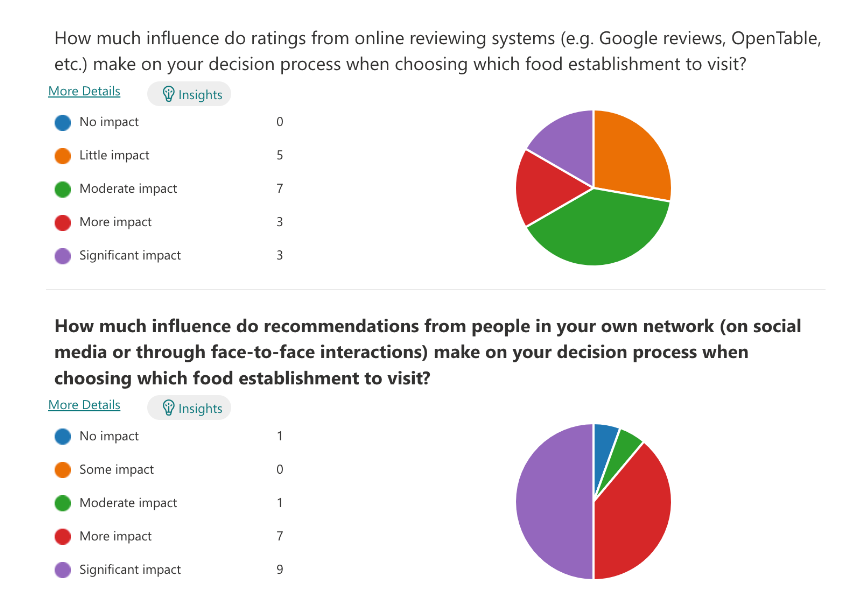
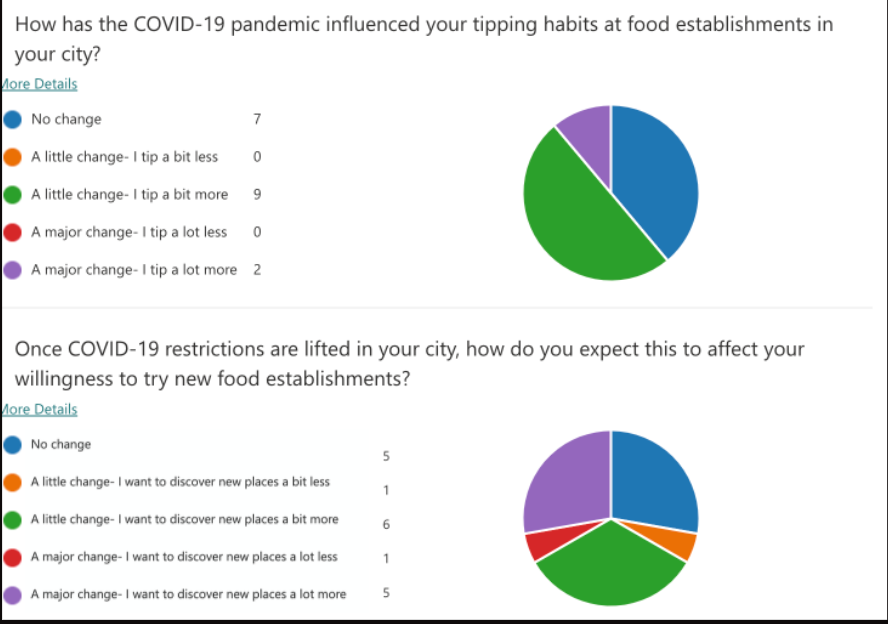
Quantitativeevaluation
Next, we wanted to guage how COVID impacted people's consumer behaviour.
Evidently, the pandemic has increased most peoples' desire to explore new food establishments in their city.
Moreover, it has increased many people's mindfulness towards demonstrating gratitude to these businesses (i.e. tipping more).

Quantitativeevaluation
Lastly, we wanted to understand how overall public ratings of local businesses influenced their decision-making process.
These results demonstrate the importance of creating a platform that optimizes reviews such that disadvantaged businesses (e.g. those that are new or small) with limited ratings have equal representation on the application.
To gather a deeper qualitative analysis of these themes, we conducted interviews with 3 participants about their specific behaviour. We also described our general goals for the project to gauge their interest in what we hoped to target.
Qualitative
evaluation
“The application's ability to filter through illegitimate reviews sounds really helpful. I generally use Google Reviews and notice that most comments come from like 5 years ago, and I have no idea if that problem is still relevant to this day. It will be helpful to see if businesses change their practice over time.”
-Interviewee A
“I’m not sure if this application would help me build relationships, but it would definitely help maintain my current friendships as it sounds like it would incentivize me to plan coffee dates with friends”
-Interviewee B
"If a place has many solved problems I will think more positively of them because it means they are trying to improve their service"
-Interviewee C
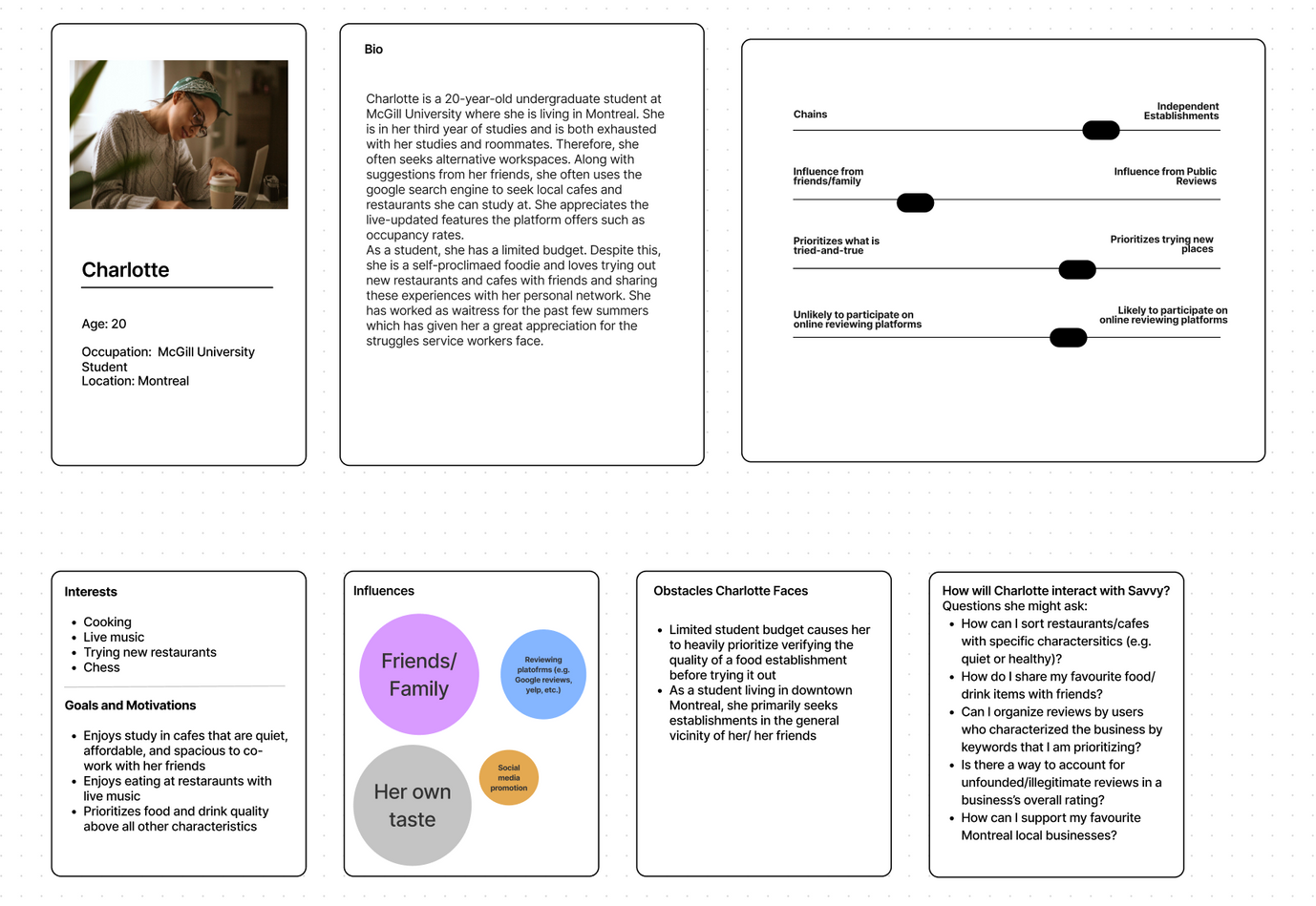
Persona
scenario
On an average school day, our primary persona Charlotte has completed class early and is looking for a place to continue her work. Consulting Google's voice assistant to find a “quiet cafe,” Charlotte is dismayed at the lack of relevant results and the search process and decides to take to the streets instead. As she consults our alternative, SavvySpot, a friend of hers, Jeff, is seen waving at her from across from the other side of the street.
After a few minutes of chatting, Charlotte invites her friend to study together at a nearby café. However, Jeff has a previous commitment and is unavailable. To not disappoint Charlotte, Jeff sends Charlotte a few Savvy Points for a designated coffee shop. “My treat!” says Jeff, who soon disappears into the crowd. Charlotte follows the map toward the shop. Some hours later, Charlotte leaves with disappointment on her face. “I wish the music could be lighter,” she murmurs. In re-consulting her phone for an alternative, a flag automatically appears on her screen:
“How was your experience with our café today?”
Charlotte is able to choose a positive or negative response. Choosing negatively, she is instantly connected to the owner by way of interactive chat. Charlotte explains that she was simply looking for somewhere quiet to study. Both Charlotte and the business owner receive points for their participation, and a flag is produced, “Problem solved!”
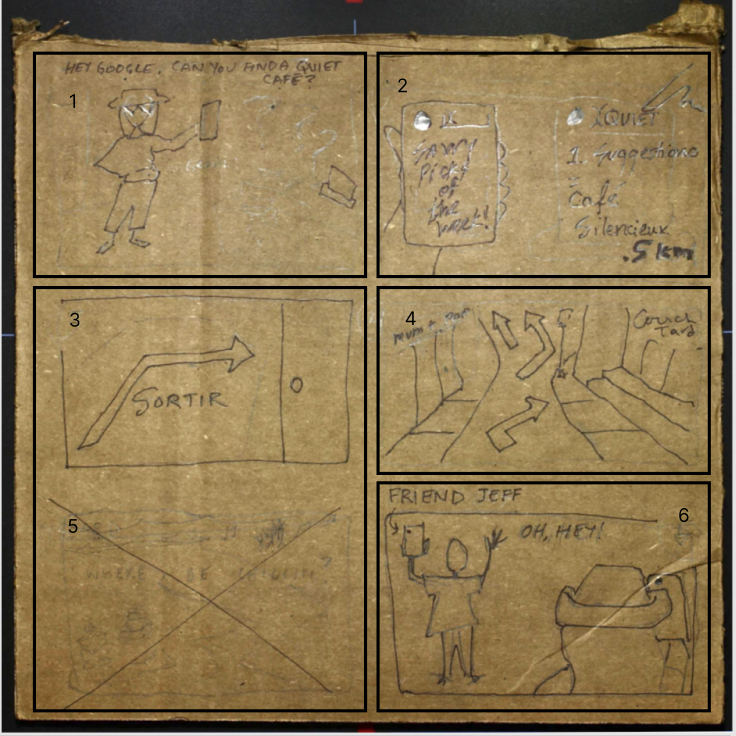
Storyboard
1. Our primary personae, Charlotte, is tasked with a noisy and chaotic apartment. She uses a voice command to search for a quiet cafe
2. SavvySpot is able to give her recommendations and incorporates her past search-related metadata into found results
3/4 Charlotte exits her home and is confused by choice in the streets also
5. Rejected scenario: Charlotte seeks friends on the Lachine Canal
6. Charlotte is encouraged to see her friend Jeff as she has been meaning to meet him for coffee
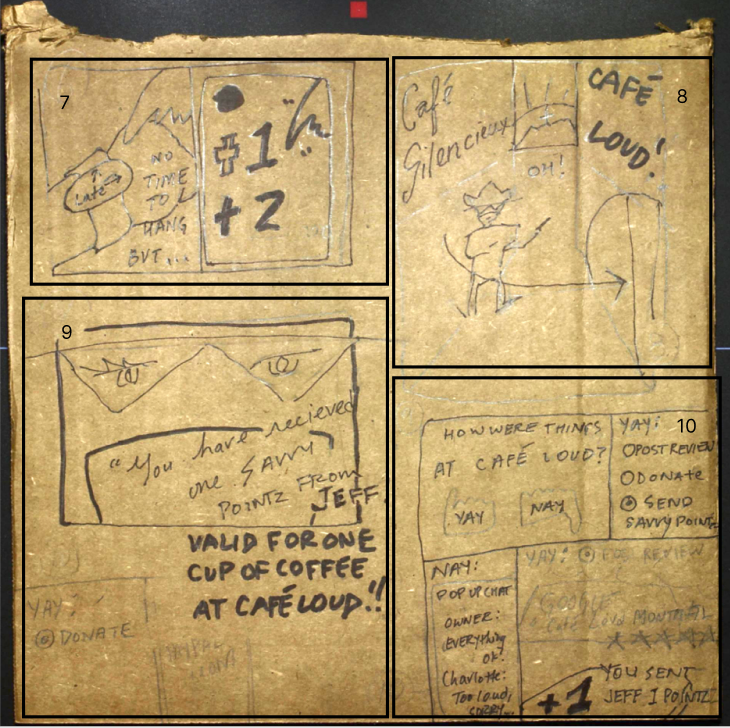
Storyboard
(cont.)
7. Jeff is hurried, he points to his watch and then his phone. He uses Savvy-app to send a point to his friend good for one coffee at his recommendation, Cafe Loud
8/9 Charlotte receives the point and excitedly changes course toward Cafe Loud
10. Upon leaving the café, Charlotte receives a flag requesting feedback with choices that lead her to further options
12. Charlotte chooses to chat with the owner, and then sends her friend a Thank-you credit anyway
digital prototype
The idea of designing a discovery application for local food establishments came from the observed need to find new local food establishments and support them in showing gratitude by introducing them to wider audiences.
Click to access the interacitve prototype
Later, we looked at the most popular platforms for discovering new food establishments and conducted a series of interviews. Our intention was to come up with a design that covers the unanswered needs of the users, especially the users in our target demographic.
digital prototype
We decided to add an option for searching with keywords because we wanted to cover the need for finding places with specific criteria that are important for our main demographic.
These criteria are not always present on currently available platforms, and may include things such as the overall vibe of a place and whether or not it is an optimal study environment.
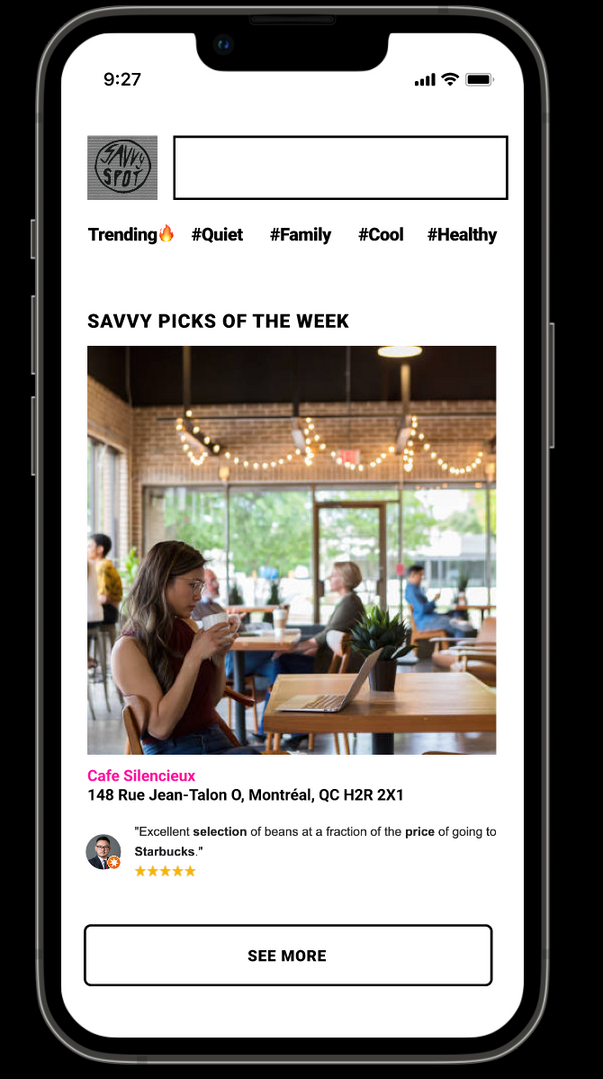
- Sidescrolls and interactive elements encourage interaction and user participation
- Client metadata is incorporated to create accurate searches that engage machine learning and artificial intelligence models
- Social networking and accompanying links to external websites well reflect social patterns and trends
digital prototype
Keeping in-line aesthetically with competitors’ sites, we have decided to highlight geographical elements and our internalized points system in profile pages in part to encourage positive feedback and focus the user in their experience
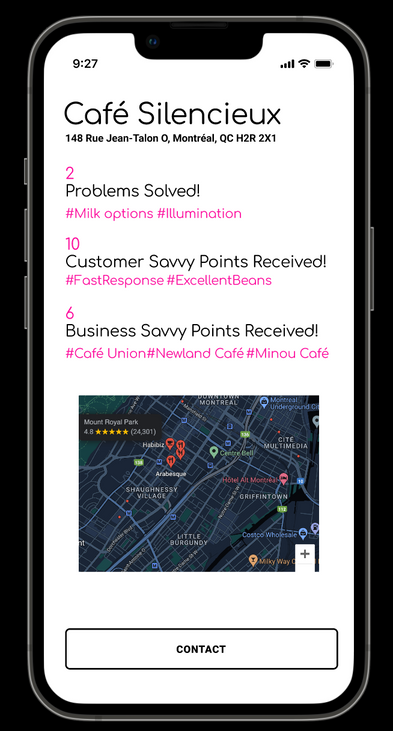
The effect is a clear and transparent understanding of the businesses reputation and clientele.
Additional details may be added to profile pages such as multimedia elements and or data-driven activities like occupancy graphing, promotions for services, or live-stream audio and video.
digital prototype
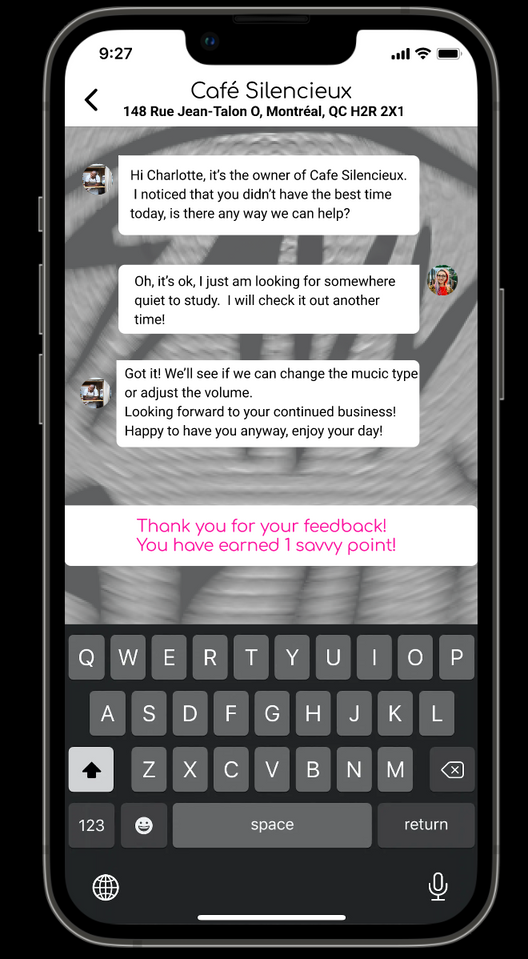
The option to discuss issues with the owner aims to help keep the overall reviews more positive and establish a better relationship between owners and customers. This feature also draws positive attention to the owners who are actively trying to prevent or solve poor client experience.
Additionally, by having the option to flag the problems as solved, customers have the ability to showcase their gratitude to the establishment for attending to their concerns.
digital prototype
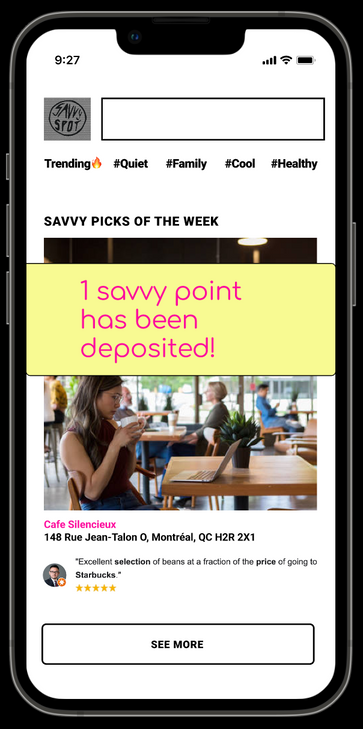
Our digital prototype portrays a familiar scenario that engages chat and administrative relays (aka: "toasts") that center solving a problem.
We have included a search bar that highlights the importance of tags and filters while allowing a gateway to communication and social media-interconnected elements that simulate (and stimulate) real-life interaction.
In keeping our target user demographic in mind, we incorporate interactive graphic design elements that draw users in yet utilize familiar-looking interfaces such as those featured on contemporary social media platforms.
MAin features
1)
The ability to see recommendations based on keywords:
2)
The ability to send other users points:
3)
The ability to discuss problems with owners and resolve them:
The users can search three key words describing some qualities they want in a cafe/restaurant (quiet/ study/ party/…) and SavvySpot will recommend multiple options that fit their criteria using both the keywords and their history. The users then can click on one of the results to view the cafe/restaurant profile. In the video Charlotte searches for a quiet spot and gets Cafe Silencieux as a top result.

Users can send their friends who are also Savvy users points to a specific place that they think is worth trying. The points can then be redeemed at the specified cafe/restaurant. In our video prototype Charlotte's friend Jeff sends her points to Cafe Loud which he thinks is a good place for her to try.

Users receive a flag asking them about their experience after leaving a restaurant or cafe. If they are not happy, they may chat with the owner about their experience and if after discussion they decide that the response from the owner was satisfactory, they can mark their problem as resolved.

Feedback
Reactions to our video prototype were primarily positive and the idea and primary functions were clearly understood. Points of confusion included details of the still-undetermined points system and how the communication channels between client and business owner would work, especially at higher-volume restaurants. Some concerns about consent are addressed in wondering how obligatory interactions are - for instance, are we penalized for not following up on a negative review? There is a question about whether seeking accountability is perhaps invasive and could lead to conflict rather than resolution. Overall, the themes of friendship and positivity are well received and encouraged. Moreso than the point or credit systems, the interviewees reflected our understanding that people prefer to frequent places upon advice from friends, and the trust in a personal network is possibly one of the greater incentives to use the app.
redesign: Stage 1
In migrating from the paper prototype utilized in our team's video prototype, changes to our design were significant. We were able to treat our viewers with obvious flags and buttons for our illustrated functions (search, point-sharing, chat), however traditional elements and designs won-out in the digital prototyping process.
Familiarity is essential to encouraging new users to experiment with their media, and we found that chat agents and more traditional flags created a tailored and modern exhibition of the ideas created within our iterative paper and video prototyping.
The innovative spirit of our idea was maintained in choosing obvious animated social graphics, ones that may in the future forway into immersive experiences with emotionally-driven extensions that focus on positivity and gratuitous action.
redesign: Stage 2
Based on the feedback we received, one aspect of the next stage of the design process will focus on how users who submit a negative review might navigate the application should they choose not to correspond with the business owner in a private chat.
Despite Savvypoint incentives, some users may still not feel like reading or participating in interactional situations. Therefore, in order to avoid negative ratings submitted without any kind of review whatsoever, we will derive a list of fixed 'positive' and 'negative' descriptions associated with each keyword a restaurant can be characterized by. Users will have the option to scroll through this list and select the one(s) that were most fitting to their experience. For example, if a keyword of a restaurant is "study," an example of a negative fixed description can be, "too loud."
This feature incapsulates one of the defining features of SavvySpot- providing a platform where all businesses (big or small, new or old) are given a fair voice on a rating platform.
redesign: Stage 2(cont.)
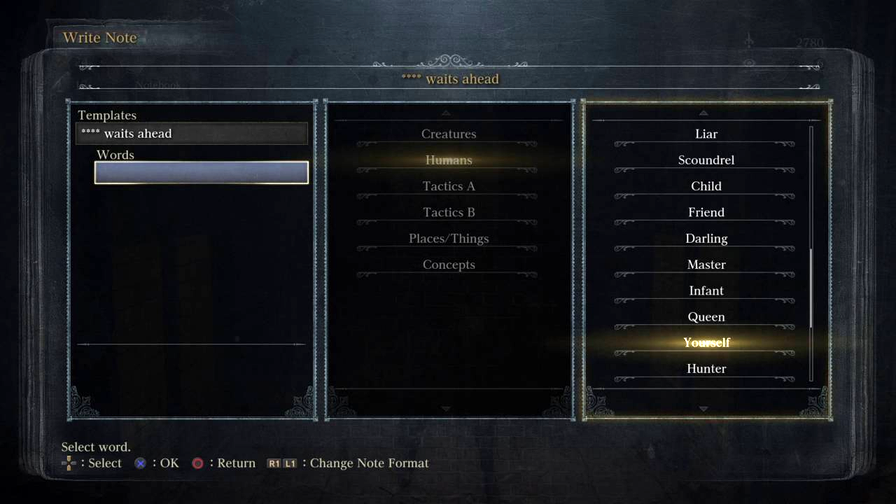
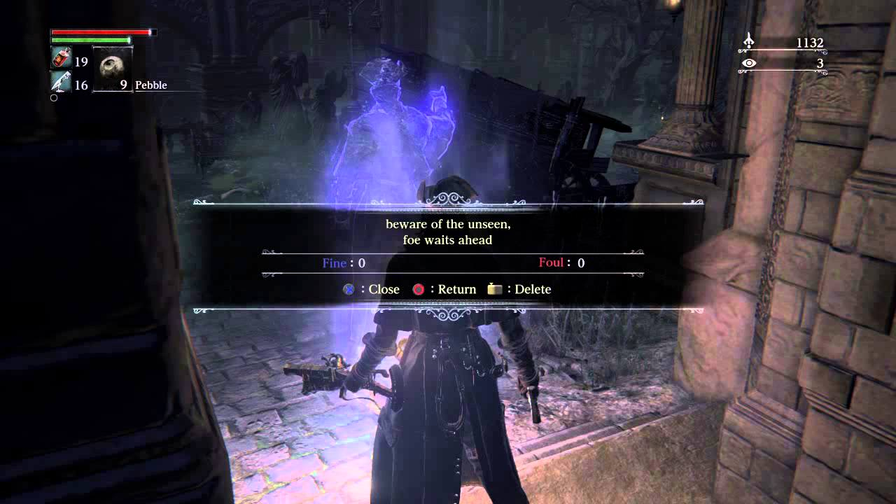
See the message system from the PS4 game Bloodborne as an example.
future work
Future versions may infiltrate small business organizations and/or engage financiers looking to develop our points system into a working economy, one that stimulates primarily our local business economy.
As a localized example, SavvySpot has the potential also to extend to international markets and/or create interlinking networks between cities.
Smart wear technologies and data-tracking accuracies may make responsive design experiences seamless for the user as their devices and modes of communication interact to aid in everyday tasks and decision-making.
As a clear asset to established review platforms, specifically Google Reviews, SavvySpot has the potential to provide a big payoff to financial backers and users alike as our point system is intended to symbolize real capital. The possibilities in regards to user traffic, behavioural tracking, and use of existing advertising revenues are maximal.
